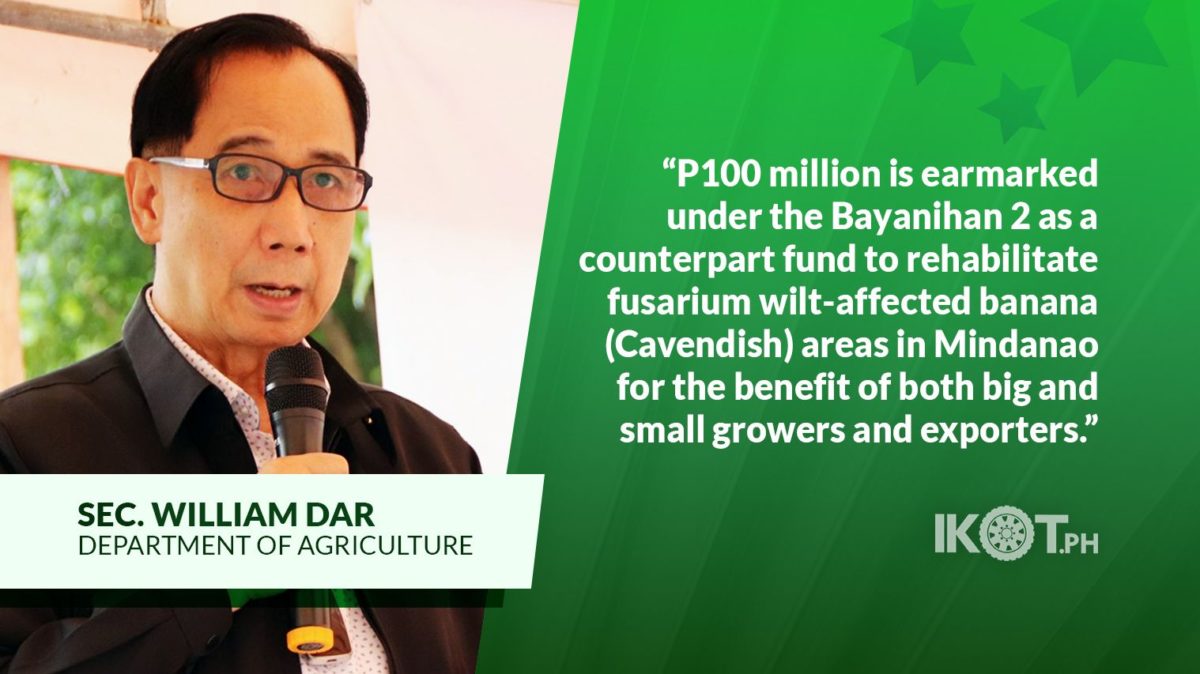The Department of Agriculture (DA) is allotting a total of P262.7 million to bankroll efforts to produce banana varieties resistant to fusarium wilt, and other development initiatives to further increase the production of quality bananas for both domestic and export markets.
Agriculture Secretary William Dar said of the total amount, P100 million is earmarked under the Bayanihan to Recover as One Act (Bayanihan 2), as a counterpart fund to rehabilitate fusarium wilt-affected banana (Cavendish) areas in Mindanao for the benefit of both big and small growers and exporters.
Dar challenged the officers and members of the Pilipino Banana Growers and Exporters (PBGEA) to match the DA’s P100-M allotment to carry out a sustainable research and development (R&D) program to control fusarium wilt and rehabilitate affected areas, during the group’s virtual 27th joint annual general assembly recently.
“I challenge the (PBGEA) leadership to also put a counterpart funding for the very research issues that you would like to pursue. I am not going to mention how much you will commit, but we will gladly welcome your share,” the agriculture chief said.
The R&D program will involve the establishment of a system to ensure the production via tissue culture of quality banana resistant varieties and distributing these to farmers to rehabilitate and re-plant disease-damaged farms.
For his part, PBGEA Chairman Alberto Bacani said he expects fellow members — composed of the country’s 24 top banana growing and exporting companies — to agree on a counterpart amount in their next meeting to match the DA’s P100-M fund.
Bacani also pledged their group’s assistance to the agriculture head’s call to help validate and correctly assess the extent of the Panama disease infestation in Mindanao, saying: “We agree that there should be a formal mapping out of areas affected by fusarium wilt.”
Also known as “Panama disease,” fusarium wilt is caused by a soil-borne fungus. It is the first disease affecting bananas to have spread globally in the first half of the 20th century.
The epidemic started in Central America, but at the end of the 1980s, the so-called “TR4 strain,” to which Cavendish cultivars are susceptible, was isolated from samples from Taiwan. It has since spread through Asia and reached Africa. It is feared to herald the end of banana species if the disease is not controlled.
“For the first seven months of 2020, the Philippines exported $1.034-billion worth of fresh bananas, down by 10.7 percent from the year-ago level of $1.158 billion.”
For the first seven months of 2020, the Philippines exported $1.034-billion worth of fresh bananas, down by 10.7 percent from the year-ago level of $1.158 billion, according to the Philippine Statistics Authority.
The decline in exports is attributed to the raging Panama disease affecting banana farms and plantations in Mindanao.
Dar said he has instructed the agricultural attaches based in China, South Korea, and Thailand to monitor the situation closely and thoroughly.
“I am afraid we are already losing our traditional market share. Given the current situation, our markets still have the disposable income to buy bananas, most especially at this time of a pandemic. There is simply no reason for them not to buy. And yet, the Philippines is losing in the export war. What happened?” he asked.
“If left unchecked, this will substantially reduce the Philippines’ exports, disrupt trade in the international markets, and cause suffering on banana growers, farmers, workers and their families, which may lead to social unrest.”
“If left unchecked, this will reduce substantially the Philippines’ exports, disrupt trade in the international markets, and cause suffering on banana growers, farmers, workers and their families, which may lead to social unrest,” Dar pointed out.
In addition to the P100-million seed fund for the planned Fusarium wilt research center, the DA will also implement the “Cardaba” (saba) industry development program, with funding of P120 million to cover 10 provinces: North Cotabato, Lanao Del Norte, Davao Del Sur, and Agusan Del Norte in Mindanao; Samar and Leyte in the Visayas; and Apayao, Cagayan, Quezon, and Oriental Mindoro in Luzon.
Further, the DA in its proposed 2021 budget has included a P42.7-million fund under the agency’s high-value crops development program for various banana industry initiatives that include:
· Production, cleaning, and distribution of quality planting materials;
· Upgrading of 14 tissue culture laboratories;
· Enhanced R&D on banana varietal improvement, and control and management of pests and diseases;
· Procurement and distribution of farm machinery;
· Conduct of training and extension on Good Agricultural Practices (GAP); and
· Institutional development and empowerment of banana farmers’ groups.

